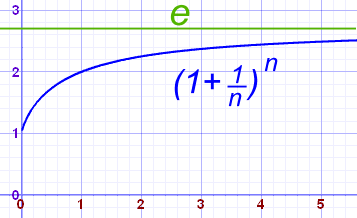e (Euler's Number)

The first few digits are:
2.7182818284590452353602874713527 (and more ...)
It is often called Euler's number after Leonhard Euler.
And Euler is spoken like "Oiler".
e is the base of the Natural Logarithms (invented by John Napier). And Euler is spoken like "Oiler".
e is found in many interesting areas, so it is worth learning about.
Calculating
There are many ways of calculating the value of e, but none of them ever give an exact answer, because e is irrational (not the ratio of two integers).But it is known to over 1 trillion digits of accuracy!
For example, the value of (1 + 1/n)n approaches e as n gets bigger and bigger:

| n | (1 + 1/n)n |
| 1 | 2.00000 |
| 2 | 2.25000 |
| 5 | 2.48832 |
| 10 | 2.59374 |
| 100 | 2.70481 |
| 1,000 | 2.71692 |
| 10,000 | 2.71815 |
| 100,000 | 2.71827 |
Another Calculation
The value of e is also equal to 1/0! + 1/1! + 1/2! + 1/3! + 1/4! + 1/5! + 1/6! + 1/7! + ... (etc)
(Note: "!" means factorial)
The first few terms add up to: 1 + 1 + 1/2 + 1/6 + 1/24 + 1/120 = 2.718055556And you can try that yourself at Sigma Calculator.
Remembering
To remember the value of e (to 10 places) just remember this saying (count the letters!):- To
- express
- e
- remember
- to
- memorize
- a
- sentence
- to
- simplify
- this
2.7 1828 1828
And following THAT are the angles 45°, 90°, 45° in a Right-Angled Isosceles (two equal angles) Triangle:
2.7 1828 1828 45 90 45
(An instant way to seem really smart!)An Interesting Property
Just for fun, try "Cut Up Then Multiply"
Let us say that we cut a number into equal parts and then multiply those parts together.Example: Cut 20 into 4 pieces and multiply them:
Each "piece" is 20/4 = 5 in size
5×5×5×5 = 54 = 625
Example continued: try 5 pieces
Each "piece" is 20/5 = 4 in size
4×4×4×4×4 = 45 = 1024
The answer: make the parts "e" (or as close to e as possible) in size.
Example: 10
| 10 cut into 3 parts is 3.3... | 3.3...×3.3...×3.3... (3.3...)3 = 37.037... |
| 10 cut into 4 equal parts is 2.5 | 2.5×2.5×2.5×2.5 = 2.54 = 39.0625 |
| 10 cut into 5 equal parts is 2 | 2×2×2×2×2 = 25 = 32 |
Try it with another number yourself, say 100, ... what do you get?
Advanced: Use of e in Compound Interest
Often the number e appears in unexpected places.For example, e is used in Continuous Compounding (for loans and investments):
Formula for Continuous Compounding
No comments:
Post a Comment